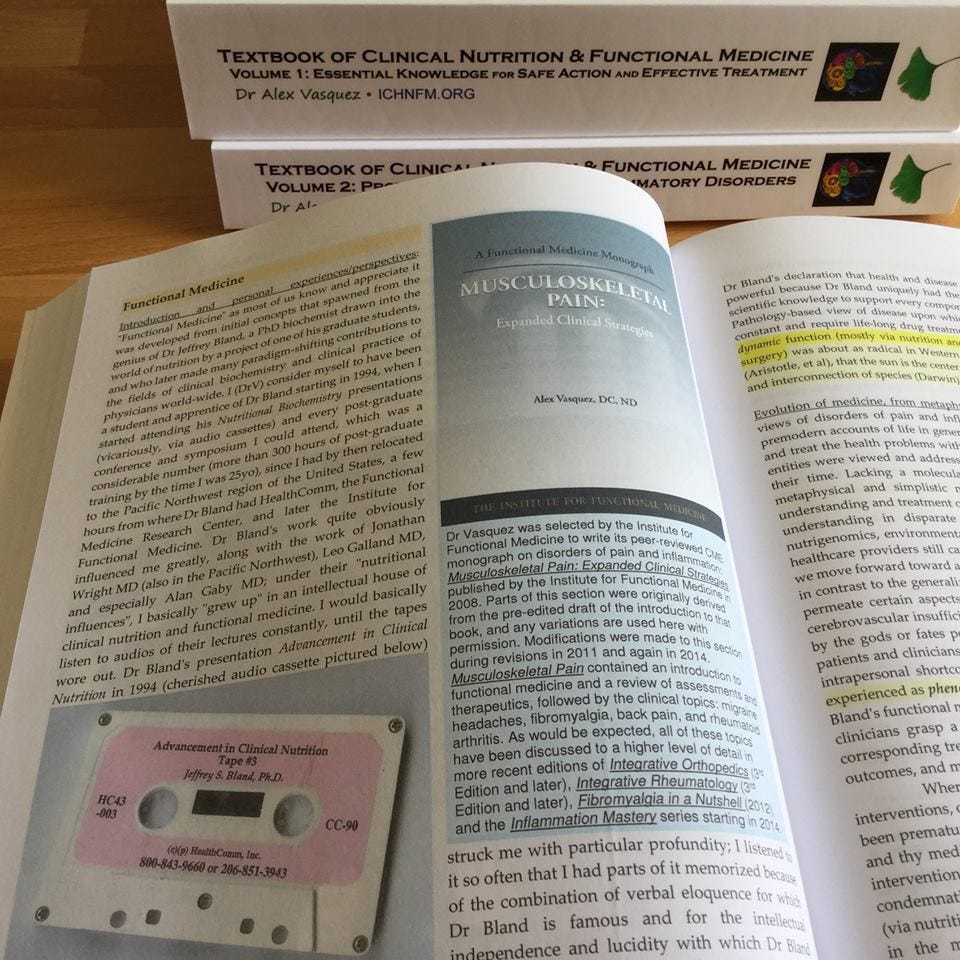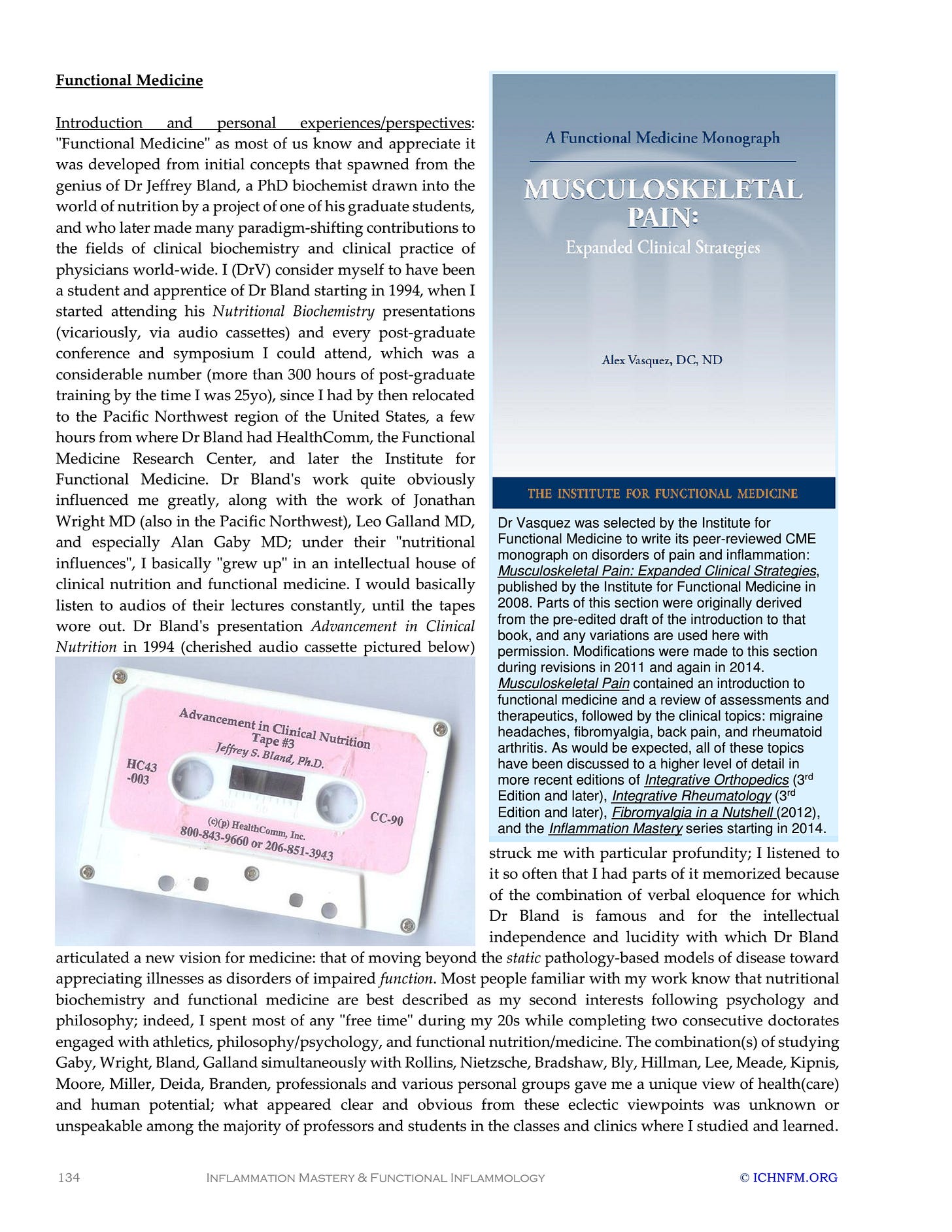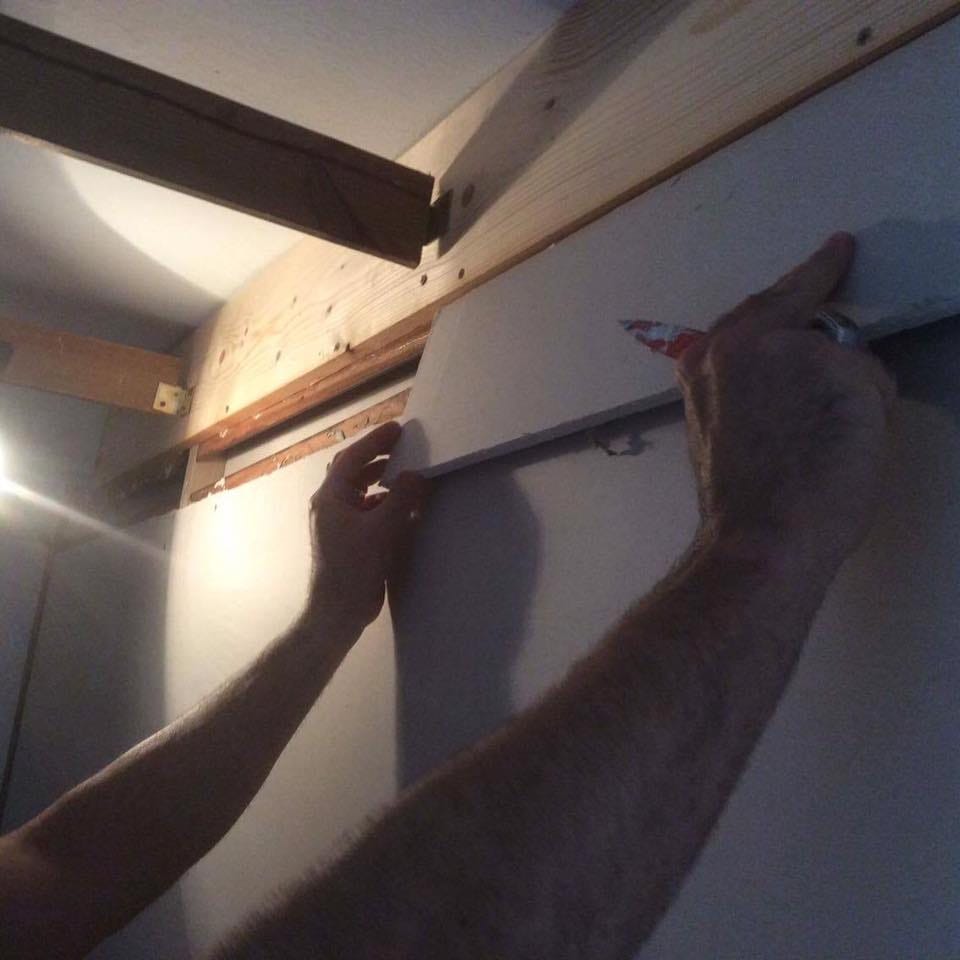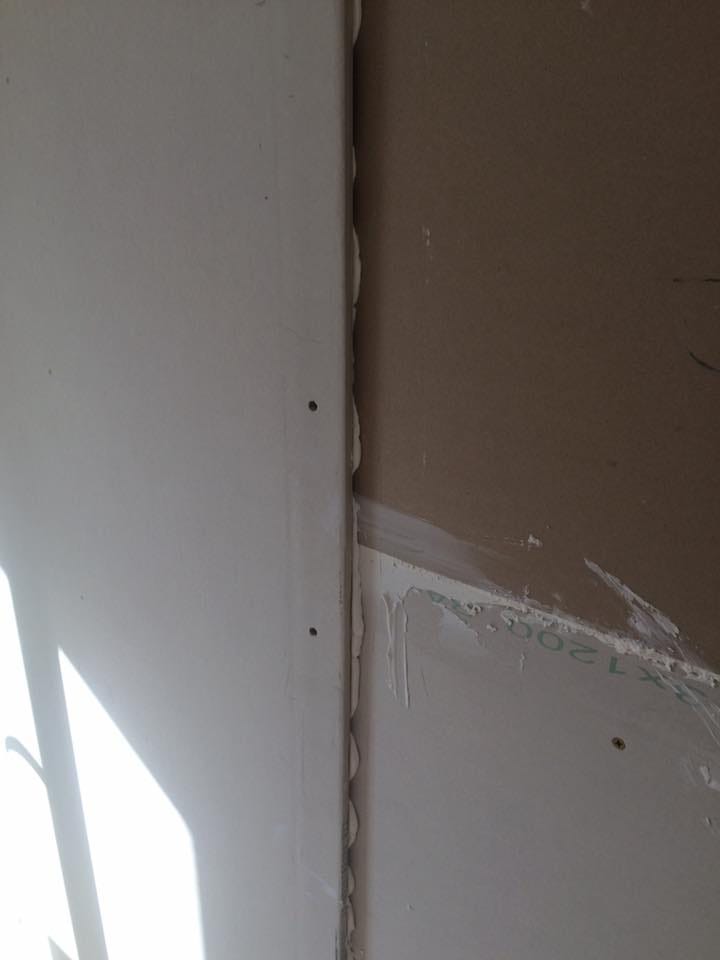Human Microbiome and Dysbiosis in Clinical Disease: Reintroduction and the story behind the book-video course
Here briefly I tell the story of—and reintroduce—my course Human Microbiome and Dysbiosis in Clinical Disease, the most difficult course I've ever constructed
Sections:
Introduction
The Early Years (1994-2006)
The Middle Years (>2006-2014)
The Modern Era of Dysbiosis Research (>2015)
The Book (“Human Microbiome and Dysbiosis in Clinical Disease” is included in Chapter 4 of Inflammation Mastery: Textbook of Clinical Nutrition and Functional Medicine) and Video Series (2015-2017)
Video #1: Course Introduction & Clinical Impact of Microbial Molecules: Introduction to the human microbiome and dysbiosis; terms and definitions, clinical relevance and contextualization
Video #2: Physiologic and Pathologic Mechanisms of Dysbiosis
Video #3: Prototypic Clinical Patterns of Dysbiosis-Induced Disease
Video #4: Clinical Approach: Testing Microbes vs Treating Dysbiosis and How the Clinical Approach to Dysbiosis Differs from the Approach Used to Treat Infectious Disease
Video #5: Dysbiosis by Location—The Mouth
Video #6: Dysbiosis by Location—The Sinuses and Respiratory Tract
Video #7: Dysbiosis by Location—Genitourinary Tract
Video #8: Dysbiosis by Location—Blood, Tissue, Parenchymal Dysbioses
Video #9: Dysbiosis by Location—Skin and Environmental Dysbiosis
Video #10: Dysbiosis by Location—Prototypes of Gastrointestinal Dysbiosis
Video #11: Dysbiosis by Location—Gastrointestinal Dysbiosis Solutions: a) First 2 hours, b) Next 38 minutes, c) Next 33 minutes, d) Final hour
Video #12: Gut-Brain Connection: a) Part 1—2 hours, b) Part 2—4 hours
See updated/dynamic course index here
Introduction: I developed a high level of expertise on the topic of dysbiosis early in my career as a clinician and educator. By the mid1990s, two events converged to facilitate this eventuality: first was the development of functional medicine (1994) as a formalized concept if not legitimate intellectual structure; second was my becoming ill (1995) with the gastrointestinal dysbiosis which I would endure, fight against, and successfully manage for the next 20 years. Enduring the condition myself on a daily basis forced me to dive deeper into understanding the condition’s causes and treatments; alongside my personal experience was my clinical experience in successfully treating hundreds of patients, and I incorporated all of this personal and clinical experience into my articles (Nutr Perspect 2006), books (Integrative Rheumatology 2006), and post-graduate presentations (eg, when I was a presenter at the Institute for Functional Medicine from 2003-2013).
The Early Years (1994-2006): Because of my intellectual interest in clinical nutrition and functional medicine, and because of the urgency of my own personal health condition, I studied and read and listened to virtually anything and everything I could get my hands on, which at that time especially included the audiocassette programs by Drs. Jonathan Wright, Alan Gaby, Leo Galland, and Jeffrey Bland. At that time in the mid-1990s, Dr Bland was giving frequent weekend seminars especially in the Pacific Northwest region of the United States which is of a large part of the reason why I relocated from Texas to Oregon and Washington at that time. By that time, Dr. Galland had introduced the concept of “leaky gut” and was probably the leading clinical expert (along with Dr Marty Lee, then of Great Smokies Diagnostic Laboratory) on dysbiosis; I attended any lecture that was logistically feasible and virtually memorized their audio cassette lectures. Everything I learned at seminars and through articles and audiocassettes was applied by me to my own case management, along with whatever precise or piecemeal advice I could get from the more than 17 different clinicians I saw while seeking help for my condition. During this time I graduated from chiropractic college and started naturopathic medical school where I learned directly not only from Dr Gaby but also Dr Walter Crinnion, who at that time was very clearly one of the world’s leading clinical and academic experts in Environmental Medicine; I saw Dr Crinnion as a private patient because by this time my gastrointestinal dysbiosis had developed into various complications including hormonal disturbances (ACTH-unresponsive adrenal insufficiency), multiple chemical sensitivity, and various food allergies manifesting as blistering skin rashes.
Image (below) of one of the many audio-cassettes that I essentially memorized from repeated listening while I was learning all I could about functional medicine and trying to heal my own health problems. Page image excerpted from Inflammation Mastery: Textbook of Clinical Nutrition and Functional Medicine.
The MiddleYears (>2006-2014): By the time I had published several professional articles on dysbiosis and had published my textbook Integrative Rheumatology (now Inflammation Mastery) which detailed the role of dysbiosis in various diseases such as rheumatoid arthritis and psoriasis, I was reasonably content to let that topic rest for a while during the years that I was busy with medical school, postgraduate training, an academic position, and international relocation. Of course I kept an eye on advancements in the field and continued to publish and present on the topic including for example a short article on “Role of Western Diet in Inflammatory Autoimmune Diseases” in Current Allergy and Asthma Reports (Volume 14, Issue 1, January 2014).
The Modern Era of Dysbiosis Research (>2015): By roughly 2015 the research and perspectives on the topic of dysbiosis and the various microbial colonizations was clearly starting to advance and actually change in tone from the previous data. As we might expect, the research was changing from a pathologic perspective (ie, disease) to more of one based on molecular biology (ie, function). Both of these perspectives are correct, and they both have their place in clinical practice; I notice that most of the modern articles appear to be completely ignorant of the pathologic basis for dysbiosis-induced disease. Whereas earlier articles focused on pathologic mechanisms induced by specific molecules and specific microbes, the newer generation information focused more on metabolites such as the short chain fatty acids and the effects that these have on gene expression, histone acetylation, neuroinflammation and immune phenotype modulation, what I have called “nutritional immunomodulation” in Chapter 4 of Inflammation Mastery.
The new book and video series: In 2015, I decided to start a new postgraduate course that I would deploy online by videos and printed materials; the title of this video course and the corresponding small textbook is “Human Microbiome and Dysbiosis in Clinical Disease.” I started writing the book by updating my previous materials which as I recall amounted to approximately 80 pages of information growing that to roughly 140 pages for the new monograph, which was later included in Chapter 4 of Inflammation Mastery: Textbook of Clinical Nutrition and Functional Medicine. I recall that the process of updating that material was enjoyable and simultaneously painful because I had new ways of organizing the material which required many hours of reformatting and restructuring, in addition to reviewing and adding new material. I published the book in May 2015 having the expectation that I would then produce the video course in approximately six days by recording one hour of video every day for a week. Again, after more than doubling and restructuring my printed material for publication in a small book, I thought I was ready to produce the video course of six hours over the course of six days. I was completely wrong about this.
Instead of simply repeating what I had said in the book, I decided that each video should represent its own new material which essentially meant “re-creating the wheel” with each video. The easier strategy would have simply been to quote myself out of my own book into the videos, but I took the harder route. I wanted to elevate in advance the topic, and at the same time I was also advancing my abilities to produce and edit video. Now, more than six years later, I’m estimating that each minute of finished video was costing me at least one hour of video editing, such that a one-hour video was requiring 60 hours of editing, obviously not including the study and preparation of the materials that went into the presentation. Currently in 2021, I’m much faster at that process but it still takes roughly 20 hours of editing for each finished hour of polished video.
In order to produce high-quality audio, I needed to use a professional-level recording studio, but these were hard to find and impossible to access during the European vacation months of summer, when virtually all nonessential businesses are closed. So I opted to build a recording studio in our flat in Barcelona, where we were living at the time, but that proved functionally worthless because the cement and stone walls transmitted sound from all of our neighbors, including piano practice, arguments, babies crying, and jack-hammering for the removal of old walls. The next best remedy was renting a soundproofed hotel room on days that I needed to record, but this of course involved packing and relocating along with computers, monitors and microphones every time I needed to create another recording. The more reliable option was simply to completely relocate, so I leased an apartment that had a quiet attic that I could use for recording. There, I worked as hard as possible for the rest of 2015 into 2016, at which time we relocated again to a small flat/apartment that I purchased where I could build a soundproofed recording studio. I did the construction myself and used vibration-absorbing materials such as wood, solvent-free plastics, and overlapped drywall (in contrast to the typical European construction materials of stone and cement, which easily transmit sound from one neighbor and one building to the next). From this new homemade soundproofed studio, the video series was completed in early 2017.
Heath benefits of the course—my personal results: The benefit to high-level teaching is of course that the teacher/professor also gets to advance his/her own learning and appreciation of the material. In this situation, I was able to gain personal benefit in the alleviation of my chronic gastrointestinal problems through the information I learned while developing the course. In fact, I can easily and honestly describe it as life-changing. Within the first few months of the course, my girlfriend and I translated some of the research information into a therapeutic recipe that we quickly adopted as a daily routine and which I eventually helped to develop into a commercial product. My health improved rapidly and dramatically within the first week of use, and I’ve maintained my improved health—based on this single intervention described in the course—now for more than six years.
Informational benefits of the course: As a direct result of developing this course, the information I learned also translated into additional professional publications including a small book on autism as well as at least three peer-reviewed publications:
Neuroinflammation in fibromyalgia and CRPS is multifactorial. Nat Rev Rheumatol 2016 Apr;12(4):242. doi: 10.1038/nrrheum.2016.25 pubmed.ncbi.nlm.nih.gov/26935282
Biological plausibility of the gut-brain axis in autism. Ann N Y Acad Sci 2017 Nov;1408(1):5-6. doi: 10.1111/nyas.13516 pubmed.ncbi.nlm.nih.gov/29090837
Correspondence regarding Cutshall, Bergstrom, Kalish's "Evaluation of a functional medicine approach to treating fatigue, stress, and digestive issues in women" in Complement Ther Clin Pract 2016 May. Complement Ther Clin Pract 2018 May;31:332-333. doi: 10.1016/j.ctcp.2016.10.001 pubmed.ncbi.nlm.nih.gov/27814977
Educational/Instructive benefits of the course: I would say that I was at least minimally competent in video presentation production when I started the program, but certainly I gained new skills over the two years of creating this particular course. Between 2015 up until 2018, I greatly improved my ability to edit audio and video and certainly by now I think most people will appreciate that my videos have taken on their own style, especially incorporating numerous overlays to provide additional information without interrupting the flow of the conversation. The first video (2015) in the series that introduces some of the basic concepts and terminology continues to be quite good in my opinion, but if we look at the improved production of a more recent video made in 2021, I think that at least some people will be able to notice some improvements in the production and the underlying structure of the video presentation. For convenience and to provide closure to this overview, I’ve provided both of those videos here on this page. [Newsletter recipients please note that videos posted on the website healthythinking.substack.com may not be visible embedded within the email newsletter.]
Video from 2015:
Video from 2021:
Dr Alex Kennerly Vasquez (introduction; brief Bio-CV)writes and teaches for an international audience on various topics ranging from leadership to nutrition to functional inflammology. Major books include Inflammation Mastery, 4th Edition (full-color printing, 1182 pages, equivalent to 25 typical books [averaging 60,000 words each]), which was also published in two separate volumes as Textbook of Clinical Nutrition and Functional Medicine (Volume 1: Chapters 1-4; Volume 2: Chapter 5—Clinical Protocols for Diabetes, Hypertension, Migraine, Fibromyalgia, Rheumatoid Arthritis, Psoriasis, Vasculitis, Dermatomyositis and most other major inflammatory/autoimmune disorders); several sections have been excerpted including Antiviral Strategies and Immune Nutrition (ISBN 1502894890) (aka, Antiviral Nutrition [available as PDF download] and Brain Inflammation in Chronic Pain, Migraine, and Fibromyalgia. Dr Vasquez’s books are available internationally via bookstores such as BookDepository, Amazon.com, Barnes and Noble, ThriftBooks, AbeBooks, BetterWorldBooks, WaterStonesBooks and his new Telegram channel is https://t.me/DrAlexVasquez.








